
Pierre Menard's The Asteroids
A downloadable game for Windows and Linux
The Asteroids itself.
Excerpted from the unpublished biography of my late friend Pierre Menard:
...After the failure to be hired at Sierra, he took a support staff job at McMurdo Station in Antarctica, which culminated in his tragic death in a refuse-pile dynamite accident in 2000. He appears under an obvious pseudonym in several chapters of Nick Johnson’s excellent Big Dead Place (Feral House, 2005)
As far as the public is concerned, Mr. Menard’s output begins and ends there. But this exile to the Antarctic darkness was not the end of his work in game design. He told me in an email dated September 6 1998 that he had been working in secret on a new game. (He had limited access to a computer in Antarctica, and his work was conducted entirely with pencil and paper.)
I turn now to this other work: the subterranean, the interminably heroic, the peerless. And— such are the capacities of man!— the unfinished. This work, perhaps the most significant game of our time, consists of a detailed design document detailing the single player mode, high score system, and basic control scheme of the 1979 arcade game Asteroids.
He did not want to produce another Asteroids clone —which is easy— but the Asteroids itself. Needless to say, he never contemplated a mechanical transcription of the original; he did not propose to copy it, and indeed the legalities of copyright precluded a reproduction of the code, art, and sound assets. In any case, he did not have access to the source code, and he hadn’t actually seen an Asteroids machine since the late 1980s.
‘My intent is no more than astonishing,’ he emailed me from McMurdo in September of 1998 ‘The final term in a theological or metaphysical demonstration—the objective world, God, causality, the forms of the universe—is no less previous and common than my famed game. The only difference is that the philosophers publish the intermediary stages of their labor in pleasant volumes and I have resolved to do away with those stages.'
[...]
[Rains, Logg, and Walsh(The authors of the first Asteroids)], for example, wrote:
‘GAME OVER!’ Written in 1979, this is merely an ending, limited by the computing power of the 6502 processor and reflecting the mundane arcade conventions of the time.
Menard, on the other hand, writes: ‘GAME OVER!’ The game is over. It is an astounding idea. Menard lived in a time when it was clear that games were no passing fad; thousands of games were being released each year, with no end in sight, and as for his Asteroids, a game could be restarted with the simple flick of a button. Yet Menard denies these obvious truths, and instead invites the player to live in a tiny, finite, self-contained ludic world, in which there are only asteroids, spaceships, aliens, and death everlasting. It is a meditation on the very nature of reality!
[...]”
Alas! His work was cut short by the aforementioned dynamite accident, the design documents were thrown away, blasted into pulp, and shipped to a landfill in New Zealand. I have here tried to reconstruct his design and translate it into a playable game; I have typed it in, in the manner of those programs which used be to published in the back of computer magazines in the early 1980s.
Scoring is as follows:
Large rock = 20
Medium rock = 50
Small rock = 100
Large alien = 250
Small alien = 1000
An extra life is awarded every 10000 points.
The following concessions to gaming on a modern pc have been made:
**The game may be run at multiple resolutions, which can be accessed by pressing the esc key.
**A bind menu for keyboard control has been added, which can be accessed by pressing the esc key.
**The default controls have been changed from arcade controls to the following:
Turn left = left arrow
Turn right = right arrow
Thrust = up arrow
Fire = spacebar
Hyperspace = down arrow
**Support for an xbox controller has been added, though this is experimental and may not always work as expected.
Turn left/turn right = left analog stick
Thrust = A
Fire = X
Hyperspace = Y
(Players will note that this is not the most intuitive control scheme. Asteroids is not meant to have intuitive controls.)
**A splash screen has been added that looks nothing like the game, replacing the cabinet art that looks nothing like the game.
Everyone should read Jorge Luis Borges' Pierre Menard, Author of the Quixote. It is only a few pages, and it is wonderful. The arcade version of Asteroids is the future, in a dark room, with the volume turned up.
=============
Please note that the current linux build targets Ubuntu and might not work on other distributions.
| Status | Released |
| Platforms | Windows, Linux |
| Author | Ben Bittner |
| Genre | Shooter, Action |
| Made with | GameMaker, GIMP |
| Tags | Arcade, artgame, Asteroids, Hand-drawn, hello-world, Singleplayer, Space, sweded |
| Average session | A few minutes |
| Languages | English |
| Inputs | Keyboard, Xbox controller |
Development log
- Linux buildAug 06, 2018
- Update to 0.91Aug 05, 2018
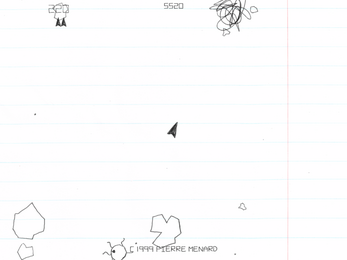
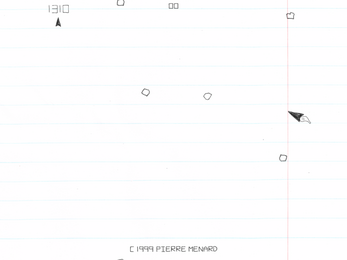
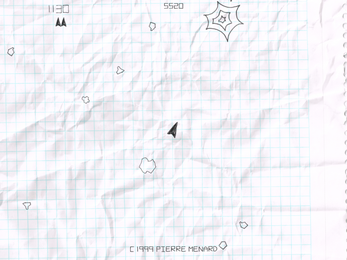
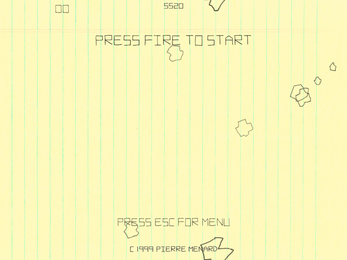
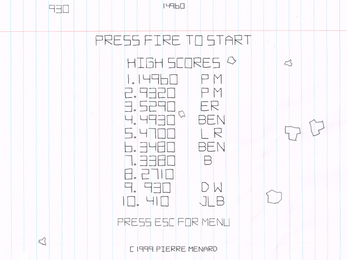
Comments
Log in with itch.io to leave a comment.
Menard conceived of his Asteroids in September of 1998, a mere 9 months after the release of Robotron 64, a typical, even paradigmatic, reimagining of the seminal 2D classic Robotron: 2084 using the 3D graphics of the Nintendo 64 console. As such, Menard's Asteroids can only be seen as a deliberate rejection of the turn-of-the-century videogame zeitgeist which saw the entire history of video games through the lens of the new 3D graphics processing technology.
In 1999, making a video game was widely seen as a work of translation. Landmark works such as Mario 64, Tomb Raider, and Ocarina of Time reimagined traditional 2D gameplay in 3D spaces. Even games like RayForce, Yoshi's Story, or the aforementioned Robotron 64, confined as they were to a single plane, could only conceive of video game graphics in terms of polygons. Games that continued using sprites for technical reasons such as Doom, the Donkey Kong Country series, or Mario Kart 64 based their sprites on pre-rendered 3D models so as to affect the appearance of polygonal graphics.
In this context, Menard's Asteroids stands athwart the march of history and shouts, Stop!
The design of the 1979 Asteroids was clearly an attempt to escape the confines of a single flat screen, to create a space that is boundless, if not endless; planar, but topologically toroidal. Menard's 1999 Asteroids, however, represents a flattening, a confinement. The player's viewpoint, accustomed in other games to following an avatar as it traverses space, is now locked in place, able only to witness the ship's endlessly wrapping path, a futile attempt to escape the bounds of the single screen.
In the 1979 Asteroids, space ships, asteroids, and even letters and numbers are composed by the direct motion of an electron beam from vertex to vertex. But Menard's game is composed of jagged sprites, groups of discrete pixels, using thousands of colors to alias those pixels into approximations of pure, straight monochrome lines. This futile attempt to create vectorized lines with crude pixels stands as a reproach to the video game industry of 1999's attempts to create smooth shapes with the even cruder polygons.
But in 2018, Ben Bittner's re-invention of Menard as a video game developer comes after the indie game Renaissance of the 2000s. Steam and Humble Bundles, Xbox Live and PSN, websites and cell phone app stores overflow with games that celebrate, recreate, and build on every era of video game development.
In graphics, Flash games produced a fusion: vector graphics rendered on pixelated screens. The Playstation 3 showcased its high-resolution graphics with flOw, producing figures nigh-indistinguishable from straight lines. AAE and VectorMAME developed techniques for emulating the vector graphics of Asteroids itself on high-resolution displays.
In the context of a video game landscape that contains everything from Pong to Overwatch, from Zork to Skyrim, the impulse to create Asteroids, choosing elemental gameplay, well-defined scope, simple shapes drawn with straight lines: all these are purely aesthetic and ludic decisions. In the modern video game color palette, red and green, gold and purple, black and white, are all equally available and the artist may choose according to her taste. In 2018, all that is necessary to create Asteroids is the desire to play Asteroids.